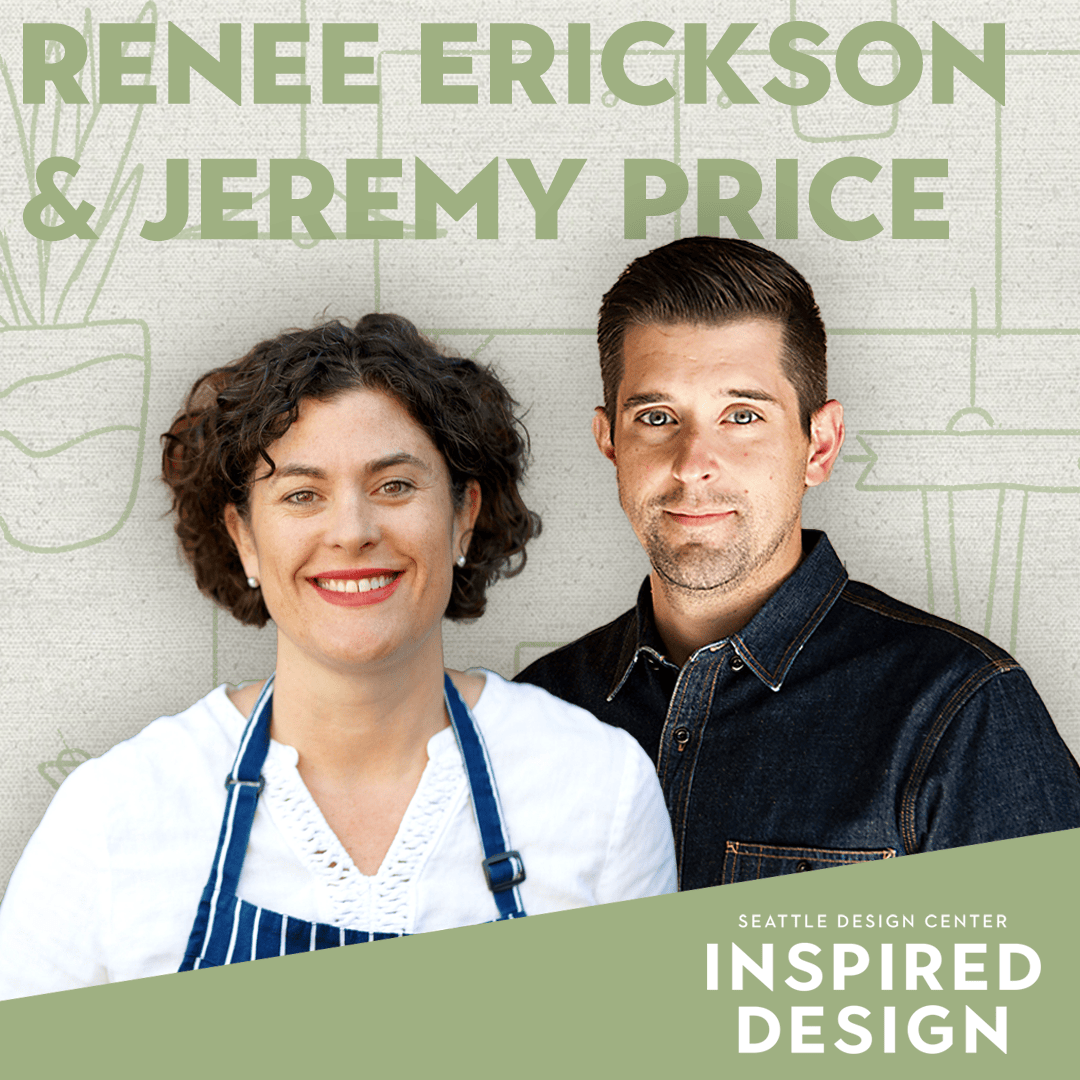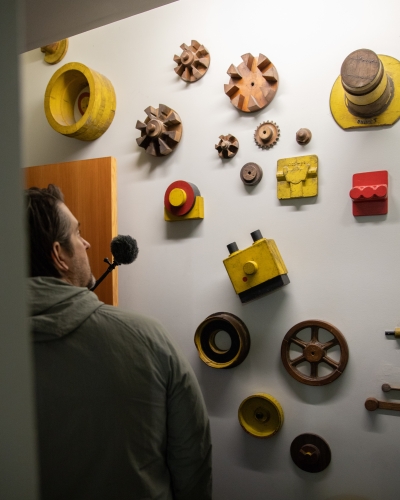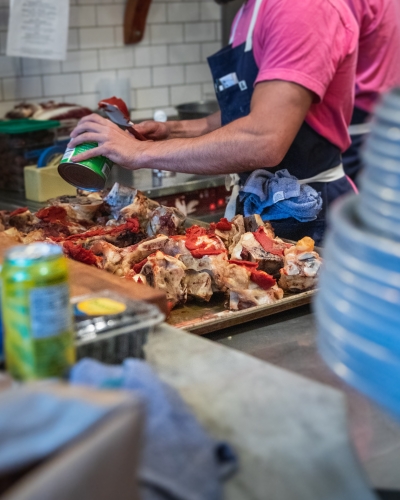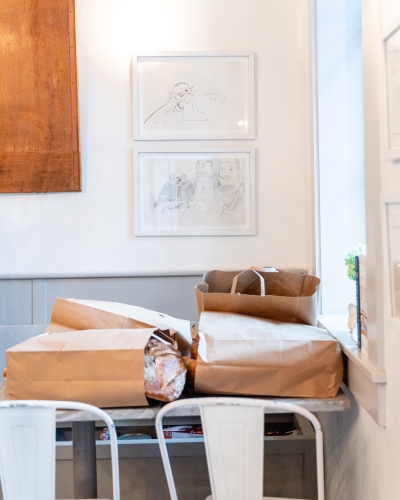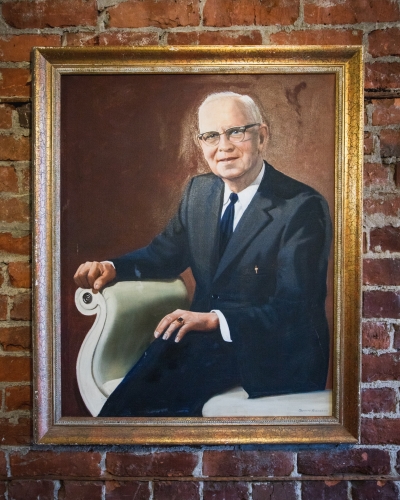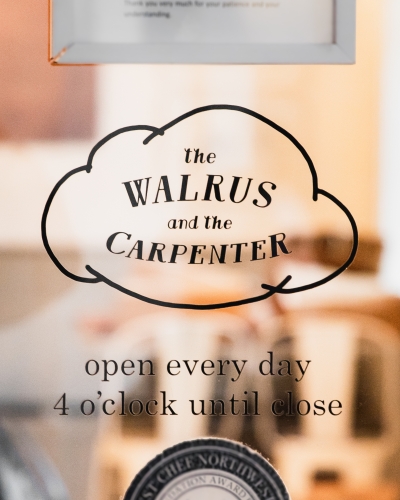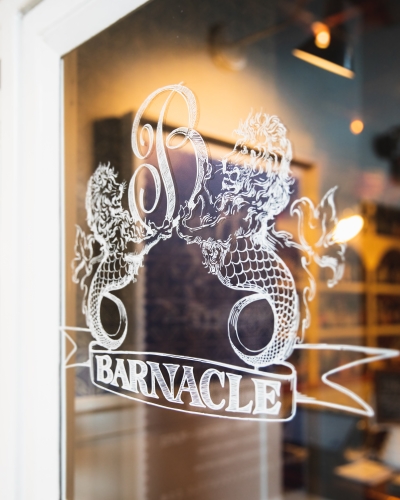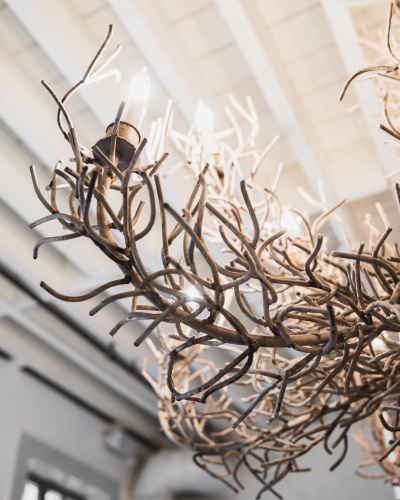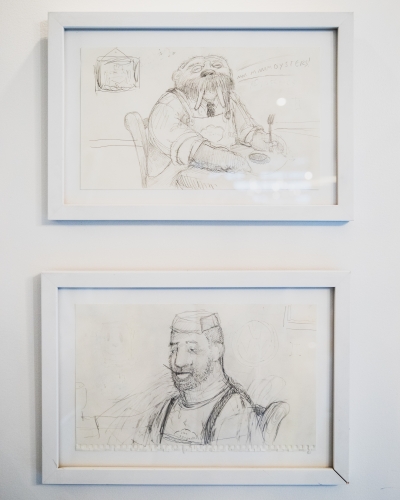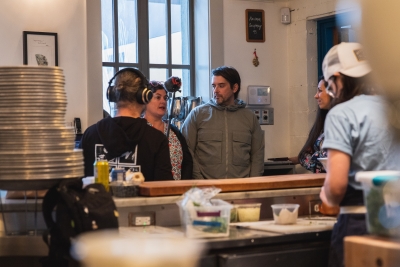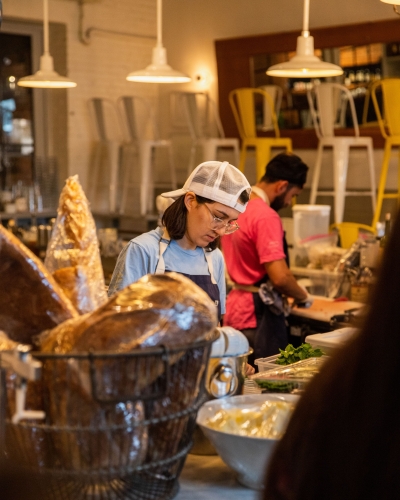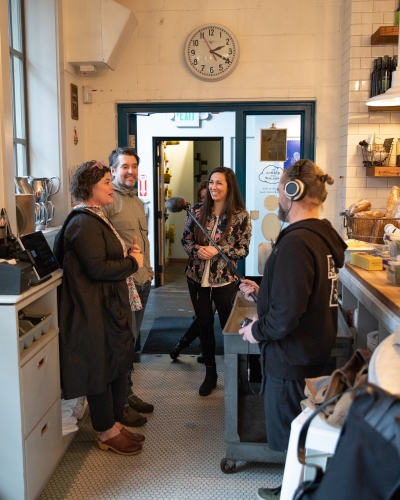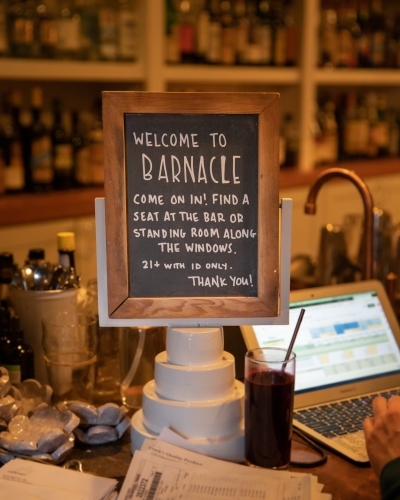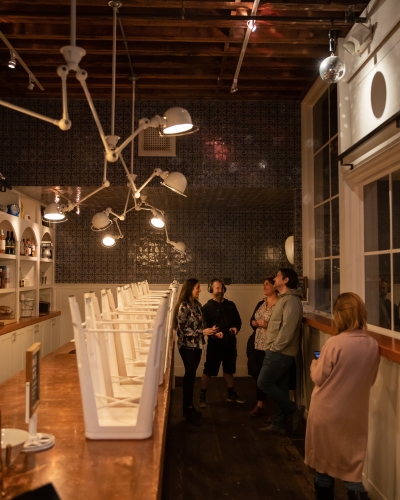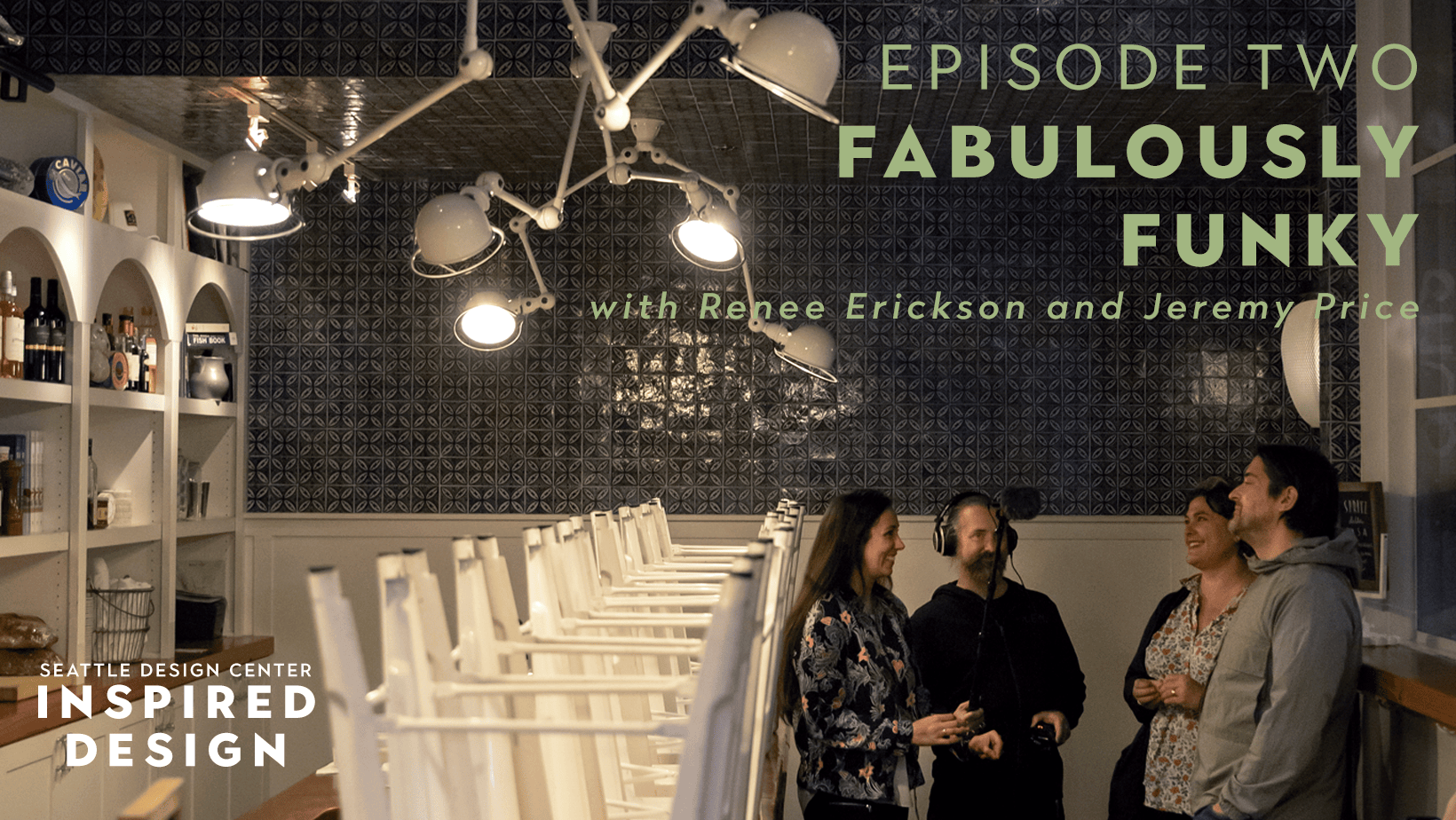
Renee Erickson & Jeremy Price | Fabulously Funky
In this episode of Inspired Design, we head to The Walrus and the Carpenter in Ballard to meet up with James Beard Award winning chef and author Renee Erickson, and her business partner, co-founder, and designer of Sea Creatures, Jeremy Price. This restaurant was their first joint endeavor over 12 years ago and gifts them with sentimental and insightful memories. We learn how they have honed their creative process to give guests the ultimate setting for a memorable meal.
Explore this Episode
Behind the scenes
EPISODE’S LOCATION
Values
Intent on creating a fun, lively, and approachable oyster bar in their back yard — a neighborhood place where the very best in food and drink would be served in a cozy, welcoming setting — friends Renee Erickson, Jeremy Price, and Chad Dale began work on The Walrus and Carpenter in the winter of 2009.
SEE MORE OF SEA CREATURES ESTABLISHMENTS
Sea Creatures is a family of restaurants, locally owned and operated by James Beard Foundation Award-winning chef Renee Erickson and partners.
SEE ALL OF THE PRICE ERICKSON PROJECTS
Price Erickson Interior Design
Price Erickson is an established interior design firm with over 15 years experience in residential and commercial interior design. Price Erickson is pleased to offer interior design and project management services to select clients.
Principals: Jeremy Price, Renee Erickson
Inquiries: info@priceerickson.com
RENEE ERICKSON’S BOOKS
Renee’s newest book – Getaway: food & drinks to transport you
Episode Transcript
Speaker 1 (00:00):
So I love being in restaurants. I love going to restaurants. I love cooking, but I think even more so I love restaurants.
Speaker 2 (00:09):
I’m Gina Colucci with the Seattle design center every week on inspired design, we sit down with an iconic creator in a space that inspires them this week. We sit down with chef author and restaurant tour, Renee Erickson and her longtime business partner and interior design specialist, Jeremy Price. Hello.
Speaker 3 (00:29):
Hi, welcome. Thank
Speaker 2 (00:30):
You. I’m Gina, Gina
Speaker 4 (00:31):
And Jeremy.
Speaker 2 (00:32):
Nice to meet you
Speaker 1 (00:33):
Renee. Nice to meet you.
Speaker 2 (00:35):
Renee and Jeremy met years ago when Renee was looking to bring spirits into her first restaurant boat street cafe and hired Jeremy and his dad to renovate the bar. You may remember boat street cafe originally located the very bottom of queen and hill kind of across from this martini bar called teeny bigs, which is gone now, but maybe that gives you a good reference. It was quintessential Renee at first, a little unassuming, but then you entered into this Oasis and it was so cute and decorated. It just popped. Renee now owns 13 unique restaurant spaces in Seattle, and we caught up with her and Jeremy in front of the iconic walrus and the carpenter. It’s their first joint endeavor founded in 2010. The restaurant is housed in a large brick structure.
Speaker 4 (01:25):
This is the Coltran building, uh, in Ballard here in Seattle.
Speaker 2 (01:29):
Uh, originally a Marine supply business over a century old
Speaker 4 (01:32):
We’re kind of in the front area, the building here where all the casting happened. And if we could get in these spaces over here, you’d see the old, like gantry where they would, um, you know, the crucible of like Moton metal would get poured in the form. So it was like very much like a working Marine space. Um, and originally when they reached out to Renee to kind of get us to come into the building to do a restaurant, they like imagined us taking all of it. Um, and yeah. <laugh> oh, you laugh about that. Yeah. I mean, it would’ve been like a 200 seat restaurant. It would’ve just been a crazy, uh, which is harder in Seattle, particularly like in a neighborhood like Ballard, which is a little quieter, but yeah, so, uh, what used to be the loading dock for that Marine castings? Um, space is now where Walton carpenter. So we just kind of took the tiny little back half. So if we head down this hallway, we’ll, we’ll find our way there. That’s
Speaker 2 (02:17):
Cool. Yeah. When you first walk through the door, you’re greeted by a long hallway that runs the length of the building about a half a block long. Yeah. And if
Speaker 4 (02:26):
We keep heading back, there’s these fun, uh, painted wood molds. So when we were talking about, um, this being a Marine casting, silly, they saved all the old wood parts and they’ve kind of made like a little decor wall ahead of us here.
Speaker 2 (02:41):
The building held nearly a century of history before becoming home to some of Seattle’s top restaurants, Renee and Jeremy took us through some of that history from the unusual architecture and mixed material walls to documents from the 1940s cold shoots and phone books and even bullet holes.
Speaker 1 (02:59):
Yeah. The space itself, when we first looked had like this cliff off the back, there was like a, like a where you could drive a truck up to
Speaker 4 (03:07):
Loading dock. So, so,
Speaker 1 (03:08):
And you going towards the Walworth and the yeah, yeah, yeah. And I remember the fir when they were taking the wall apart, they found like papers from like the forties, like talking about the war and everything that they had, like used as insulation or whatever. I don’t know, is this building’s nuts, like remember in the basement yeah. Where they had, like they had, there were these like coal shoots, I think, on the street, um, that they had filled with phone books, which I think is hysterical. Cuz do phone books exist anymore? Um, no. Right. I don’t think so, but they would shoot guns at this. And so it was all like just exploded with bullet holes everywhere and it like water on the floor. Like it was definitely not a place where you’re like, this seems like a great place for a restaurant, need
Speaker 2 (03:50):
A dime. If you wanna see exactly what we’re talking about. Head to the Seattle design center website on the inspired design podcast page, and you’ll get behind the scenes images and be able to see all the little details that we cover. I notice a lot of mixed materials throughout the hallway. You’ve got brick in the entryway and then some cement was this very different when you started the process,
Speaker 4 (04:15):
It was, it was all open. And so I think to, um, demise the space, they had to put this drywall in, which is like a burn wall. So it’s a fire thing. So we ended up with, um, you know, this drywall, but in other instances where we didn’t need the burn wall for fire safety, it’s just the exposed concrete or the original brick or what have you. But yeah, these are all, I mean, I couldn’t tell you what they all are for do, but these were all molds that were used for casting. It was kind
Speaker 2 (04:41):
Of fun. And you chose to keep these
Speaker 4 (04:43):
Just yeah. Yeah. I mean, we, it was really the, um, the building architect, which is Graham Baba that I think kind of really saw what an opportunity, all these cool little things were to be the core. Yeah.
Speaker 2 (04:54):
We came to a landing between Walworth and the carpenter and
Speaker 4 (04:57):
Barnacle and we’re standing on, um, card decking, uh, which used to have cement over it. Um, and that was roto hammered off to reveal the card decking, which is kind of a fun thing. So these are like, you know, floors that you could drive a car on, like, you know, properly thick, like wooden floors. I dunno. Just kind of a cool thing. And those, uh, carding extends into barnacle. You can kind of see it. And we used to have that in walrus for like maybe the first three or four years. Um, but because of the restaurant being so busy, the Gus between the boards started to really open up and like women wearing heels would get stuck and stuff. And so like, we were like out the water. Yeah. Oyster
Speaker 1 (05:33):
Made.
Speaker 4 (05:33):
Yeah, it was really cool cuz underneath us is, um, some mechanical spaces and storage spaces, uh, for the restaurants. And so like the light from those spaces would shine through the floor, the old wood floor. And it was, it was cool. But unfortunately, yeah, it was a safety thing and a sanitary thing where we had to tile over the decking and, and walrus.
Speaker 2 (05:50):
Anyway, as we head into the restaurant, Renee tells us about her original inspiration to open a little oyster bar in the back of the building.
Speaker 1 (05:57):
I used to have boat street cafe and Chad Dale, our, our other partner, um, started coming to boat street. He was very persistent and, and pestering to get me interested in, into a space. And fortunately like Jeremy and I worked together as well. And um, he had at one point mention like if I were to ever do anything else that he would wanna partner with us. So, or with me. And so that kind of happened. But as we were looking at this space, I remember walking in, I think off of Ballard, there was like a plywood door basically. And like, like I laughed in the front earlier. Like I laughed at the idea that like they’re envisioning this to be the kitchen for the restaurant over there. And, and, and I was just like a no way it’s enormous. And you know, if you know our spaces now you’ll know that like having a like south or Western facing experience is much more interesting to me than like this dark kind of cave, like experience of a restaurant, which is very common in Seattle, not for us. So I kind of jokingly said to Chad, um, like if you let us have the back kitchen and then give us a patio, I would do it. And I didn’t think anything. I just was like, whatever. I was very afraid also of anything. I had both street, which was 60 seats and it felt big. Obviously the idea of this was ridiculous, but I wanted something small, you know, that we could kind of get our hands around 12 years later, we’re still here, which is lovely.
Speaker 2 (07:24):
The space is simple, but it’s not boring. There’s a beautiful chandelier right in the middle. And then these two large mirrors on the far wall that really open the entire space up and the back of the restaurant opens up to the alleyway and it lets in some really pretty natural light, there’s even a window. On the other side that looks into the adjacent restaurant. The energy of the space creates a really nice community feel if you’ve ever been to walrus and the carpenter, the most iconic piece of the decor is that massive chandelier that I just mentioned. Renee tells us the story of how she stumbled upon it on a trip to LA.
Speaker 1 (08:08):
The chandelier was fun. I ended up in LA with, uh, Carrie mania who works with us. Who’s one of my best friends. And we were walking around silver lake and went to this antique store. That’s sadly, no longer there. But, um, we went in and went out in the back and we were looking for a light, but not, you know, that wasn’t our, that’s not why we were in LA. And uh, this was in the backyard of this antique store with grass growing up through it. And it was like, you know, kind of just left there. I remember thinking like, oh, it looks like it’s in, you know, underwater a little bit. And so I don’t know. I must have sent y’all a picture mm-hmm
Speaker 4 (08:40):
<affirmative> yeah. I think at one time I could have told you who we thought made it. We don’t know for sure, but we think it was an artist, uh, that was working in California who, um, who made Robert. Yeah. Did like a lot of this kind of sculptural sort of stuff in like the sixties, but I mean, to me it like coral, but it is little tubes of steel that are all kind of welded together in this. Like branchy like tangled sort of Brae. And it was probably originally bright white, but you know, it’s um, probably like 50, 60 years old now. And so like what was white is now kind of, you know, gray and brown into like a, a wonderful, like kind of patina and some of the rust is kind of coming through, um, that original navel. So just is a cool kind of like, yeah, I don’t know. It’s um, I haven’t seen really anything like it anywhere, so that feels kind of fun to yeah. Hear lot.
Speaker 1 (09:27):
Yeah. It was, I mean, for sure when we decided, well then of course, like when we, I went to finally like, go ask if it was, you know, available and someone like that day or the day before had put a deposit on it. So I was like, of course. And so I asked, I was like, well, how much time do they have? And so come the end of the month, the person that was gonna buy it, didn’t buy it. So they created it up and sent it to us and we got it, which was great. Um, but yeah, it showed up like kind of in this like, okay, crate. That was a little bit, I don’t know. He was probably happy to get rid of it, but <laugh> um, we, we ended up sticking it in the back of my, it must have been my brother’s truck and took it to the brown bear car wash to get it cleaned before we took it to get, um, rewired. Cuz it, I don’t even know if it had wiring. It might have had just cut wiring in it. But yeah, it’s the best. I love that thing.
Speaker 2 (10:23):
Walworth’s in the carpenter holds so many personal touches for both Renee and Jeremy commission drawings from her friend and former teacher, Jeffrey Mitchell. Yeah.
Speaker 1 (10:31):
He’s spectacular. I adore him. They’re also, I think just so whimsical and, and layered and lovely.
Speaker 4 (10:38):
He like will send you like, here’s some drafts. Here’s what I’m thinking. Here’s what I’m working on. He sends you the drafts and the drafts are like absolutely perfect.
Speaker 2 (10:45):
He’s like salvage doors from a community space. Her brother was working on, he
Speaker 1 (10:48):
Worked at, um, the city of Renton. There are five doors originally and they were the entrance to this big, like community space. And I mean, they’re insane, massive doors. And for whatever reason, they decided they needed new doors.
Speaker 2 (11:01):
The brick lane was done by her father at age 88. He still helps with brick lane to this day.
Speaker 1 (11:08):
I just made him license brick for me yesterday.
Speaker 2 (11:11):
Even the Offwhite walls are a specific color based on a patch of fur from Renee’s beloved dog Jeffrey
Speaker 4 (11:18):
When Renee was, um, painting the second boat street or maybe it was the first, but anyway, like wasn’t satisfied with like the colors that were available. Like she really wanted this like warm, like sort of rich white color, sort of that glowy candle. Lighty kind of like white color and just couldn’t like find anything she was satisfied with. And so she took Jeffrey, the dog into the paint store and like had it, had his fur matched. And we used, he had
Speaker 1 (11:44):
These patches on his shoulders that were this like golden white. Yeah. And so I was like, I want that white. Yeah.
Speaker 4 (11:51):
Yeah. And so all the restaurants where you see this white color, this creamy white color, it’s Jeffrey White and we’ve used it everywhere, I think, except for westward
Speaker 2 (11:58):
Between the building history, the funky chandelier and the salvage doors. The phrase that comes to mind is imperfect perfectness.
Speaker 4 (12:07):
We’re attracted to kind of materials and spaces that feel like a little lived in. Um, I think that those spaces for us feel a little bit more alive as a result. Y you know, I think it’s like when you’re at a restaurant in like a mall or an airport, that’s, you know, those spaces can feel a little antiseptic cuz there isn’t isn’t that. So it’s, and it, and it’s also like the, um, having like the ingredients on display, I think, and having like, you know, the people that are like making your food for you, like visible, like all those kinds of things add more and more layers of like interest and like kind of just make the space feel dynamic in a way that if everything was like perfectly clean, perfectly smooth, you know, all sorted and tucked away, it, I think it would lose some of that energy in some of that life. We always, like, we talk a lot about like, you know, what our grandparents feel comfortable in a place or like, can I bring my dad to that place? And, and this is definitely like one of those places that works that way where like people feel comfortable here. And I think it’s because of all those sorts of things.
Speaker 1 (13:02):
Yeah. I mean, walrus feels even now, um, 12 years on like really magical in that way. Like it has this space, you know, it was like perfectly timed, I think in Seattle to have, um, I think a restaurant that felt like this where you’re like, cramed in it’s super loud, you know, the focus is on oysters, which was really uncommon back then. Um, you know, like it’s a little bit like our space too, which I think is what makes it like, you’re kind of like visiting someone’s house versus like a restaurant that’s, um, all about the guest. I mean, we are that, but it’s also like you can’t help, but like being, you know, impacted by your neighbor and you know, the server’s gonna like squeeze in between, you know, to like get stuff. So it’s, you’re kind of pushed in your comfort zone a little bit being here too, which we love. And
Speaker 2 (13:47):
It reminded me a lot of little cafes in Europe where everybody eats right next to each other and you have to be
Speaker 1 (13:54):
Social. I mean, it’s the only restaurant of ours it’s like that. So I think it’s, you know, it’s, it’s great in that way. I certainly wasn’t planned. It was just like, okay, we’ve got 700 square feet or whatever it is like, yeah, let’s cram as much in here as we can. And you know, like we really wanted the bar and the oysters to be so present when you walked in. So that kind of drove how we, we built everything around that. Basically
Speaker 4 (14:18):
This space is really, I think, special to Renee and I both, because it was the first space we created together and it, um, I know she mentioned like her dad and her brother, like working together to lay the brick patio, um, and the whole space, like from Jeffrey, giving us the art or ever had that kind of like community sort of barn raising kind of vibe to it, like my dad and I built the bank cat and we built the, um, that wine cabinet there and we built the prep table that’s in the kitchen. Um, and so, and that we didn’t really get to do that for other restaurants cuz like by that point it’s like we had restaurants and we were like kind of too busy to like be making the things ourselves. And um, so this one is like a, you know, like a real hands on kind of laborer of love in a way that, uh, the other restaurants that we’ve done together didn’t necessarily have the, that same opportunity to be.
Speaker 4 (15:06):
Um, so that’s really cool. Yeah. I used to have like crazy, uh, like stress dreams about the banquette collapsing under people like sitting on it like more than once I had this dream where like this banquette that we built, like just broke, just crushed. Yeah. Going, going on 12 ish years. Now it still, yeah. Strong, still hasn’t fallen apart yet. Yeah. Anyway, it’s a really special restaurant and I, yeah, and too, like, um, when we opened this, um, you know, this is a point in our careers where I was the GM for like the first two and a half years. And would be your host like five days a week, like greet everyone at the door. And Renee was, you know, working a station, uh, like we were briefly open for brunch and she was like our brunch chef one way or another. We’ve worked in all the restaurants, but this is I think the restaurant where we also like, I mean, I really worked here for a while, you know, for like years. So, um, it’s got that kind of specialness to it too. Like there’s that kind of a different relationship than we have with some of the other restaurants.
Speaker 5 (16:07):
Seattle design center is the premier marketplace for fine home furnishings, designer, textiles, bespoke lighting, curated art and custom kitchen and bath solutions. We are located in the heart of Georgetown open to the public Monday through Friday with complimentary parking. Our showroom associates are industry experts known for their customer service. We’re celebrating new showrooms and added onsite amenities visit Seattle design center.com for more information about our showrooms and our find a designer program.
Speaker 3 (16:39):
Alright,
Speaker 2 (16:39):
So where are walking to
Speaker 4 (16:40):
Now? Yeah. So this is barnacle. Um, and this opened in October of 2013,
Speaker 2 (16:48):
Barnacle is a thin long bar you walk in and there’s probably seating for eight people. And the shelves behind the butcher block countertops are curved and have all types of spirits. There’s these pendants that hang from the ceiling that are very angular and architectural. And then along the wall on your right hand side, as you’re walking in, it’s just this giant window looking into a hallway. So you kind of feel like you’re in a fishbowl, but with really good cocktails
Speaker 4 (17:29):
Between it being a casting Marine castings place, uh, to it becoming barnacle, um, it had a brief kind of like stint as a bike shop. So this was like a bicycle repair area. Um, and it didn’t coffee and coffee. Yeah. And for whatever. Yeah, totally. Yeah. Always <laugh> um, and sadly it didn’t work out, um, with the bike shop, but when they moved out, um, we were able to, um, sign a lease for this kind of little space and it’s become its own. Um, you know, it like people are coming to go to Walmarts typically, but it’s really nice to have this. So like we can send them somewhere to wait where they’re not having to walk in the rain or the cold or the dark. And um,
Speaker 2 (18:06):
And it’s just like a little skip hop
Speaker 4 (18:08):
Job almost like yeah. Like five steps, but yeah. Um, and it’s, it is super small. It’s kind of, this is, this is it. It’s just one long bar and then a little table, um, the opening crew here kind of jokingly called that little table, the champagne room, but it’s, you know, it’s, it’s so called the champagne should,
Speaker 6 (18:24):
Should set the champagne room, take time
Speaker 4 (18:27):
Very important. Um, so yeah, just, it’s a really, really sweet little space. And this was, um, you know, I think Renee had had the thought for a while doing kind of like a AVO or a TV type of bar where it’s like a lot of like little can snacks, like fishy things, crackers sort of things that are, um, you know, a lot of times are prepared. Um, and, and we’re just, we were plaing them and serving them, um, and kind of pairing that with a, with what at the time was kind of an eccentric cocktail program that was really just like, based on these, amaros just all these fortified wines and now you see those things, uh, a lot more commonly, but, um, at that time it was kind of a, like a, a weird thing. And we’d have to have that conversation with the guests. Like what, why, why can’t tomorrow? Why can’t
Speaker 1 (19:10):
Lots of that?
Speaker 4 (19:11):
Why can’t I get a margarita? You know, that kind of a thing. It was like, well, we don’t really do that here, but you know, here’s something you might like instead. And you know, we, yeah, we were really excited to just go crazy with the tile. Um, I was gonna say
Speaker 2 (19:21):
Yourself had your time where, you know, you didn’t really the oyster bar thing. Wasn’t cool yet. Yeah. And the, you know, floor to ceiling tile and the craft cocktails. Yeah. Where, where did that inspiration stem from travel,
Speaker 1 (19:35):
Travel? All of it. Yeah. Entirely. I would say like every restaurant of ours is somehow connected to travel
Speaker 2 (19:42):
Base of it. In light of that, I asked how travel has influenced their projects or certain locations
Speaker 4 (19:49):
For both these spaces. Cuz there’s some of the smaller spaces we have. Um, there is a bar and the ma that I think we’ve both been to, but I don’t know if we’ve been there together. Mm. Um, and it’s kind of like fifties, sixties, and they just like left it that way, but it’s really small. And like it, it’s got this like complete clown car kind of like dynamic to it where like the kitchen is somehow like you get to it’s fresh of all. Is that uh, no, it’s not first of all. Um, yeah, I would have to look, but it’s like, they, they literally open cabinet doors, like under a counter and they’re stairs. Oh yeah, yeah, yeah. And then they’re like, you know, to go get your food. And so it is like those kinds of like, just like kooky sort of experiences.
Speaker 4 (20:29):
Like we, um, don’t have a ton of that on the west coast, cuz like everything is so new and a lot of times it’s purpose built, like, you know, just knock, knock down and build the, the right thing for the thing. And I don’t think you get as weird of experience. I mean, we also have like, I think kind of tougher codes around that kind of stuff, but like those things are just so special. Like I remember that and that was probably 10 years ago that I was there and I don’t remember really too much else about it. Other than that there was like stairs in a cabinet. I don’t know. I think we really love finding the little spaces that seem like improbable. Like they feel more special. Yeah. And you just see so much more of that in Europe than you do, you know, on the west coast of America.
Speaker 1 (21:09):
Yeah. And a lot of, it’s not, um, visually inspired, but like ly, like we end up like whales was, um, I had been spending a more time going to England and, and become, or London, not just mostly London and uh, just the, um, experience around vegetables there was, was becoming something that wasn’t happening here. At least not in Washington where there was, um, the O hotel Linga group that everyone now, you know, has heard of at the time was had I think just one location. And um, you know, there was this like bountiful plethora of, of food that you could, you know, see when you walked in and then it became part of your meal. And so when we opened whales, we that’s how we started was not only, and that, that plus the wood oven was this, um, you know, very vegetable focused and like the meas and plus all the food that was gonna become your meal was basically these like beautiful, you know, ZUS or silver trays or whatever that were in front of you as you walked in. So you could kind of be excited about what was to come. And so like, I think it’s like kind of combination of like visual inspirations and, and also just like weird experiences that you remember or hold onto and want to kind of somehow translate into something here. Yeah.
Speaker 4 (22:22):
Yeah. One thing that Renee talks a lot about, at least with, with opening wall risk, is that, um, kind of at that time, like I think she had recently been to nor Albany and to Paris, um, and just had the experience, um, in both locations of oysters being like really accessible and like not fancy, there’s a really sweet little oyster bar that I remember you showing me early on called, uh Wheatie REI mm-hmm <affirmative>, um, which is even smaller than barnacle, I think. Yeah, totally. Um, but it’s like, you know, at that time in Seattle, like to go get oysters, you had to go to a steakhouse or you had to go to like a 400 seat, like tourist restaurant, um, like on the waterfront and there wasn’t really anything in between. Um, and so I think it was like kind of that inspiration from traveling where you’re like, oh, like this doesn’t have to be like a quote unquote fancy food.
Speaker 4 (23:08):
You can like have this like delicious thing, which we grow so many of in the Northwest and you can put it in this, like, you know, in a really a bar essentially is what Walmart is, is way more bar than it is a restaurant, put it in that context. And, um, it becomes kind of a new thing and, and hopefully a more accessible thing where like people are having to leave their neighborhood or like, you know, have like, you know, a, a huge, like $50 steak to also like have oysters or whatever it is, you know? So, yeah,
Speaker 1 (23:34):
It’s true. Yeah. The, um, we regime was, or is, it’s still open, um, tiny and I still like maybe one day that Seattle would be ready, but, um, you had to buy oysters by the dozen each person. Nope. Like you couldn’t share <laugh> um, you, I know, right. I loved it. Um, there was only white wine or champagne. You could get like a shrimp terrain I think, and then like poached shrimp and it was ridiculous. And the whole place, like, I mean much like walrus, I would say, like, it felt like you were like in a room that like was entirely inspired off of the colors of an oyster shell. Super cool.
Speaker 2 (24:13):
It’s not only travel that influences Renee’s design choices,
Speaker 1 (24:17):
The back bar at barnacle. I think I was watching Willow Wonka, chaga factory. Yeah. And sent you, or sent you a text if you remember the candy store in Willy Wonka, it’s like, it’s the opposite. Well, it would be like this, you know, it’s like a U shape, but I was like, oh, I think that like kind of crazy candy, you know, mania for a bar would be really fun. So that’s why the, the style or the, you know, the design is sort of inspired off of that room and that it had this like intimacy and tininess and then kind of berserk as well where it’s just, everything’s everywhere
Speaker 2 (24:50):
When you get that with the Chandel or the pendants handing over the bar.
Speaker 4 (24:55):
Yeah. Those are, um, gel day pendants, um, which is like a, uh, a French sort of task lamp or task pendant from, I think the twenties. Um, these are like new versions of the, I think it’s been in continuous reproduction, like wars aside since the twenties. And these are kind of fun ones because each pendant has kind of two of these articulating, uh, arms, like they’re just like little apparatus, you know, like they’re just fun. And like they have, um, I think a sense of movement to ’em. I mean, obviously like they’re actually kind of like a pain in the butt to reposition and to move around, but just even static. I think that they’ve got kind of like a, I don’t know, a sculptural quality to ’em mm-hmm <affirmative> like, they’re, they’re kind of kinetic
Speaker 2 (25:33):
As we sat in the champagne room, Renee and Jeremy told us more about how they met and Renee’s unique opportunity to pivot from art studies to running a restaurant.
Speaker 4 (25:44):
Renee was looking to bring spirits to both street. Cause originally it was wine and beer. So she wanted a bar and she wanted to change some of the seeding to like banquette type seating. And um, so she hired me and my dad to do that work. And, um, after that I started working, um, at bore. Jeremy
Speaker 1 (26:01):
Is the best, best boy ever is what he
Speaker 4 (26:04):
Claims to do. Yeah. I mean, I’m now retired, but I was Seattle’s easily. Seattle’s best boy for best, best boy for about two and a half years. Love that. Yeah. No,
Speaker 1 (26:12):
I don’t
Speaker 4 (26:13):
Know us now. Retired. Yeah. Now retired. Yeah.
Speaker 1 (26:14):
You hung up your, uh, your clogs. Yeah.
Speaker 4 (26:17):
<laugh> um, so yeah, working at working at the restaurant, we got to be, I think friends, um, just through working together and kind of that, that connection. Yeah.
Speaker 2 (26:25):
And Renee, do you wanna tell me kind of your history, you were going to art school and then kind of fell into this world or?
Speaker 1 (26:35):
Yeah, so I was a student at university of Washington in the, um, department of art. I have a painting degree, um, and printmaking and I needed a job. <laugh> like all college students do or should. And, uh, I drove by the first boat street and um, thought it was really charming and I needed a job. So I like walked in and um, this part of the story, I always kind of laugh. I’m like I gave him my resume, which was essentially my phone number. I got a job as a server and started waiting tables there. And Susan who started it had a full-time job in Tacoma. And I quickly realized that serving was maybe not what I was meant to do. And so I asked if I could bake or do anything else. And so I started baking in the morning before I would go to school.
Speaker 1 (27:24):
And eventually just like, because of the, um, opportunity that was there because, um, a lot of times Susan was managing from afar. There was, you know, stuff just had to get done. So you were able to do things that wouldn’t have been probably what was normally given to someone like me. So over the course of a couple, like three years, I ended up helping, you know, just like cook dinner or service and went to school in Rome, which has, you know, kind of been an inspiration for a lot of the other things we’ve created and came back and, um, worked again for Susan. And at that point she was wanting to sell boat street and I had at this point graduated and was, I thought I would be a, um, art teacher, cuz I grew up with the, you know, the best people that I knew growing up were art teachers.
Speaker 1 (28:09):
So, um, I thought that’s what I would do. And I had applied to graduate school. Um, and I wanted to go to temple university in Penn, in uh, Pennsylvania, because they had a program in Rome. I basically just wanted to go back to Rome, um, and still to this day. And uh, <laugh> I got wait listed, I didn’t get accepted. And I was basically like Susan was trying to convince me to buy boat street. I was 20, I would’ve been 25 at the time. And I was just like, you know, what am I doing? And I basically asked my family and some close friends what I should do. And they were all like, you should buy the restaurant. So I got a loan from my folks and um, bought a restaurant and that was 25 years ago. Um, <laugh>
Speaker 4 (28:56):
When I first started working for an a at boat street. Um, I had a day job at a biotech company. Um, and wasn’t super happy there. Um, it was like, it was, um, maybe a couple years after college and I had that experience where like everyone was working with were in like really different chapters of their lives, you know, like 20 years older than me married kids. And there wasn’t really like a community there. Um, and I, you know, I’d always been interested in and certainly furniture making, um, is something I just grew up with my dad. Um, like our houses were always torn apart. There was always like projects going on, like always remodeling everything. Um, so that was like in me somewhere. And I think when, like I started like, oh man, this is like, not what I want to keep doing. Like I started to kind of revisit some of those like hobbies as like, well maybe this could be a thing.
Speaker 4 (29:46):
And um, I went to school and got an anthropology degree, so it wasn’t like super applicable to, uh, to careers. Uh, so I, yeah, same with the painting degree. Yeah. So I started, uh, I started, um, going to community college to do, uh, like math, prereq, prereq, so I could, uh, apply to grad school for architecture. Cause I was like, okay, this is like something I know I like. And um, you know, maybe that could be, um, you know, a path for me and kind of at that same time as when, um, Chad started talking to Renee about these spaces. Yeah. Um, and Renee was like, Hey, I know like, I dunno if you’re interested. Um, but you know, this might be a thing we’re doing like, and I was like, oh, this is amazing. And like, I think right away, like I started drawing, uh, like layouts and kind of all that stuff and was sending ’em to Renee.
Speaker 4 (30:34):
And, um, it just felt like at that time, like a real, like kind of like fast track to like, oh man, I get to like draw stuff and like design it and build it. And like people get to use it and enjoy it. And like, I don’t have to go to school or like take on a bunch, take on a bunch more debt. We’ve probably designed like one or two commercial spaces a year for like the last, like 10, 12 years. And so it’s, um, I’ve got to do kind of that design work that I wanted to do with it, like in a, you know, not a non-traditional path, you know? Yeah. So it’s been cool.
Speaker 1 (31:05):
I was gonna say, we always kind of joke that when, you know, when people ask us about the design part, that we are like our, we design for ourselves. So we’re like the best client ever <laugh> <laugh> cause we are like, we know exactly what we want <laugh> and so much, I mean, it’s luxurious, you know, like I think that’s the kind of decadence of, of being able to do that.
Speaker 2 (31:26):
And each of them having their own personality and ideas. Right. Mm-hmm <affirmative>, mm-hmm <affirmative> which one you think personally speaks to, you know, you individually Renee, if you wanna,
Speaker 1 (31:37):
Oh man. You had pick pick the
Speaker 2 (31:39):
It’s like pick your favorite child
Speaker 1 (31:41):
<laugh> yeah. I mean, I think I would end up picking here just I think, cuz there’s so much, I like Jeremy kind of spoke to like there’s more of us here than any of them. I think our ideas are, and our aesthetic is everywhere, but like our, you know, our grit and everything ends up being here cuz we, you know, built it from ground up and, and built it like while being open too, which I think is, you know, there’s um, clearly the restaurant industry is, is, is best for, um, the younger crowd to survive the growing days. And so like the older you get, you’re not, you know, you’re not the, you’re not the team that like is standing at the end of the night anymore. So there’s, there’s camaraderie to it. That’s really wonderful. And so I think not having that in the other spaces, to the extent that we had here changes it, you know, like the, the feeling is different.
Speaker 1 (32:32):
I mean we love them all. I think we have, we know we get asked all the time, like what’s your favorite? And I think we say, I would say largely, foodwise like, whale’s my favorite, but it’s because it’s an experience that is kind of more food that I wanna eat all every day be to is obviously like ultra fabulous and decadent, but like not something you wanna eat every day or at least not anymore. Um, yeah. I mean Wilmas is, um, this like speaking of like wild spaces to design too, Jeremy can talk more about that, but um, kind of the realization of my love of Roman food for so long and not really having an outlet to serve it, cuz we, we try pretty hard to keep really clear boundaries on uh, <laugh> on what the food can be within the restaurants otherwise, you know, we, because we really want them to, to stand on their own.
Speaker 1 (33:23):
And if given it’s sort of like the grocery store analogy earlier, like chefs will be like, yeah, I want that. And I want that and I want that, you know? And so like without having the boundaries, you know, like you, everyone would end up having like asparagus with whatever, you know, and that’s not a good example, but like, you know, like everyone would want salsa, matcha on everything in all the restaurants, you know, or whatever chili crisp, the thing that’s like everyone’s in love with right now. So, um, some places that’s okay. Some places it’s not. So having that kind of boundary is really helpful.
Speaker 4 (33:54):
I would have a really similar answer to Renee as like around favorite. It’s like, what’s the occasion like, oh, like this restaurant’s perfect for this kind of a thing. Or like, this is the night I want to have right now. I’ll go here and here. Um, you know, so it’s, it’s kind of all over the place. Like whatever one I’m eating at is probably like my favorite in that moment, you know? Um, I also think too, cuz it’s like happened over, um, uh, a span of time where they kind of like, they marked time in a way for me a little bit, like in my own life, like each, uh, restaurant is sort of like a sign post for like I yep. I remember when that was being billed and this was what was going on in my life. Like I don’t necessarily have that as much with like music, but for sure with like the spaces that we have together, like that’s like, it’s like a time telling kind of a thing. And so sure. Uh, I know, I guess that doesn’t have anything to do with like what one, it’s my favorite, but like they’re all like, I don’t know. They’re like, they’re like they’re each of their time and of like what we were excited about and interested in, in that time. And so each is sort of special in that way. They become like a little memento
Speaker 2 (34:54):
As we chatted. I learned something about oysters. I didn’t know before
Speaker 1 (34:58):
The spring is like, like prime oyster season, cuz they’re, you know, the lights come back and the oysters are feeding again after like all winter just trying to stay alive. And so they’re getting plump and juicy and so by summer they’re gonna be so plum and juicy that they’re gonna be spa and ready to, you know, they’re just very, very different. So I’m almost hard. I mean, I eat it well rest a lot in the summer, but I, I don’t eat oysters unless they’re really incredibly amazing. But most of the time they’re just so Milky and creamy that they’re kind of
Speaker 4 (35:28):
Yeah. Or like real thin, like, you know, they can be they’ve spawn
Speaker 1 (35:31):
Then
Speaker 4 (35:31):
They are like, they’re not Milky and creamy. They, they can be, uh,
Speaker 1 (35:34):
You can like see right through them. Yeah. <laugh> it’s like,
Speaker 4 (35:36):
Like ghost, ghost oysters. Yeah.
Speaker 1 (35:38):
Yeah. We don’t want anyone to stop coming, but, and obviously all the oyster farmers want you to keep eating em all year round, but it is one of those, you know, like you like slap your forehead where you’re like, why on earth are people not eating so many oysters in the winter? Yeah. Blow my mind. Yeah.
Speaker 2 (35:52):
With 13 distinctive spaces, I wanted to know a little more about their design process.
Speaker 4 (35:59):
We’ve I think approached it in both ways where it’s like, there’s a space that we really love and it’s like, what can we do here? Mm-hmm <affirmative> um, and we’ve also approached it, like we’ve got this great idea, where can it working? Can it live? Um, I think we’re most successful or at least I’m happiest with the outcome when we’re approaching it. Like with a idea, um, in search of the space, uh, rather than the other way around. Not that, not that you know, I don’t know. That’s just my preference. Mm-hmm <affirmative> um, early on we had been like kind of keeping a mental file of like, oh, this would be cool somewhere. Like this idea, like this material or this kind of approach to service, like all the like little pieces that kind of come together to actually like make a restaurant. I think we would, I think we’re always kind of like thinking of those things and like telling each other, like this would be cool or I saw this thing or like, here’s a picture I took somewhere like, oh, I was at this place last night and they did this thing.
Speaker 4 (36:51):
Um, and I don’t know, like eventually like that kind of aggregates into something that you can kind of get your arm around and feels like a complete idea. Um, I really like to have that and then find a spot that, that, um, yeah. Yeah.
Speaker 1 (37:06):
I like that lot there. I mean, to have to like, I, I, it goes back to being like our own perfect client is like, if we have this vision, it makes it so much easier versus having a thing that we have to find a vision to put in it, you know, like that’s, that’s kind of feels certainly less exciting and I think, um, maybe less authentic too.
Speaker 4 (37:29):
Yeah. And I think as, as we’ve done more of this, I think that process of, um, collecting all those little ideas that like will someday add up to something, um, has become like a little bit more formalized where it’s like, I don’t know. I think like early days we would go on trips and it would be like happenstance that we would see something. And now it’s like, we’re gonna go on a trip cuz we need to be inspired. And we don’t know like what
Speaker 2 (37:52):
It is that work never ends for Jeremy and Renee. For us, they’re just about to open a new restaurant Southlake union inspired by a friend of Renee’s Cameron who sadly passed away during the pandemic. He was a fan of fried chicken and rock and roll and his energy inspired, the design and food and they will fund a scholarship in his name.
Speaker 1 (38:12):
He, um, was from the south and was this like, you know, larger than life kind of human. And he had a popup called king Leroy. And, and so we ended up, I think, I don’t know, at some point I just mentioned it to you and all the like, you know, design details have come from that. But I think to have this person and also, um, a way for us to feel motivated to do it, some of his loves will be in there. And then also kind of like some ridiculous things. And I think we both are charmed by and wanna have around.
Speaker 4 (38:42):
There’s so much like nostalgia going into the space king Leroy, like Seattle kind of nostalgia stuff that like, uh, it feels like, you know, like the shoot box shoebox, like, and the like top shelf of my closet of like all the stuff that’s like from like 20 or 30 years ago that like doesn’t quite fit in any of this world. Like this world of like, you know, like white and blue and like, like sophistication in a way this gets to be like our like uncles creepy basement, totally like, uh, kind of in the best way and the best like kind of like things that we haven’t got to do anywhere else. Cute box. Yeah, yeah.
Speaker 1 (39:17):
Box anywhere, but there, which is great. Yeah.
Speaker 4 (39:19):
And to see that glitter glitter for days. So yeah.
Speaker 1 (39:21):
You had like glitter, glitter, banquettes, like the glitter that was on the like sixties gay boat, like glitter,
Speaker 4 (39:27):
Like your bass fishing. Yeah. Like, and like the shiny, like it’s that. Yeah.
Speaker 1 (39:31):
And all the like beer memorbilia and posters and where is this gonna be? Lots of
Speaker 4 (39:37):
Summer fan Leno. Um, so Southlake union,
Speaker 1 (39:40):
We just hope to, like, we need a lot of like peanut shells and maybe some cigarette buts on the floor. Yeah. For sure. To kind of fast forward it in its time of, of existence. But
Speaker 4 (39:55):
Yeah, but that one, um, kind of to bring it back to the, the question like that one. Um, and I think this is what Renee was getting at, is that that’s what that space wants to be. I think for that neighborhood and for the people that are there, that one feels like it’s less Renee and Jeremy really need like a wings bar. <laugh> like, I, uh, but it does like, there’s not anything like that in that area. Like it’s, I don’t know. I think it’s like adding something to what’s happening there. And like, I think once like, like Renee was able to kind of like define like this menu and this like direction, like through her friend, Cameron was like, oh yeah, this is what it, what it should be. And so that’s been pretty different for us. That’s not how it normally goes. Normally it goes like, wouldn’t it be cool if Seattle had, you know, blank
Speaker 1 (40:39):
Yeah. To like have something that I, you know, clearly care about to be the center and the focal point of it all and to feel really good about why it’s being opened. It’ll be good.
Speaker 2 (40:53):
Thank you. Renee Erickson and Jeremy Price for shining a candid spotlight on your fame space while we’re in the carpenter and barnacle inspire design is brought to you by the Seattle design center. The show is produced by large media. You can find them@larjmedia.com special thanks to mechi Suzuki, Lisa Willis and Kimmy design for bringing this podcast to life for more head to Seattle design center.com, where you can subscribe to our newsletter and follow us on social media. Next time on inspired design, we head to Woodenville and sit down with John and Peggy Bigelow at their famed winery, JM sellers.
Speaker 7 (41:41):
It’s really fun to have an environment like this, where people can walk around with their glass of wine and really explore things that maybe they haven’t seen before.


